Abstract
We have determined the coding sequences of red and green visual pigment genes of the chimpanzee, gorilla, and orangutan. The deduced amino acid sequences of these pigments are highly homologous to the equivalent human pigments. None of the amino acid differences occurred at sites that were previously shown to influence pigment absorption characteristics. Therefore, we predict the spectra of red and green pigments of the apes to have wavelengths of maximum absorption that differ by < 2 nm from the equivalent human pigments and that color vision in these nonhuman primates will be very similar, if not identical, to that in humans. A total of 14 within-species polymorphisms (6 involving silent substitutions) were observed in the coding sequences of the red and green pigment genes of the great apes. Remarkably, the polymorphisms at 6 of these sites had been observed in human populations, suggesting that they predated the evolution of higher primates. Alleles at polymorphic sites were often shared between the red and green pigment genes. The average synonymous rate of divergence of red from green sequences was approximately 1/10th that estimated for other proteins of higher primates, indicating the involvement of gene conversion in generating these polymorphisms. The high degree of homology and juxtaposition of these two genes on the X chromosome has promoted unequal recombination and/or gene conversion that led to sequence homogenization. However, natural selection operated to maintain the degree of separation in peak absorbance between the red and green pigments that resulted in optimal chromatic discrimination. This represents a unique case of molecular coevolution between two homologous genes that functionally interact at the behavioral level.
Full text
PDF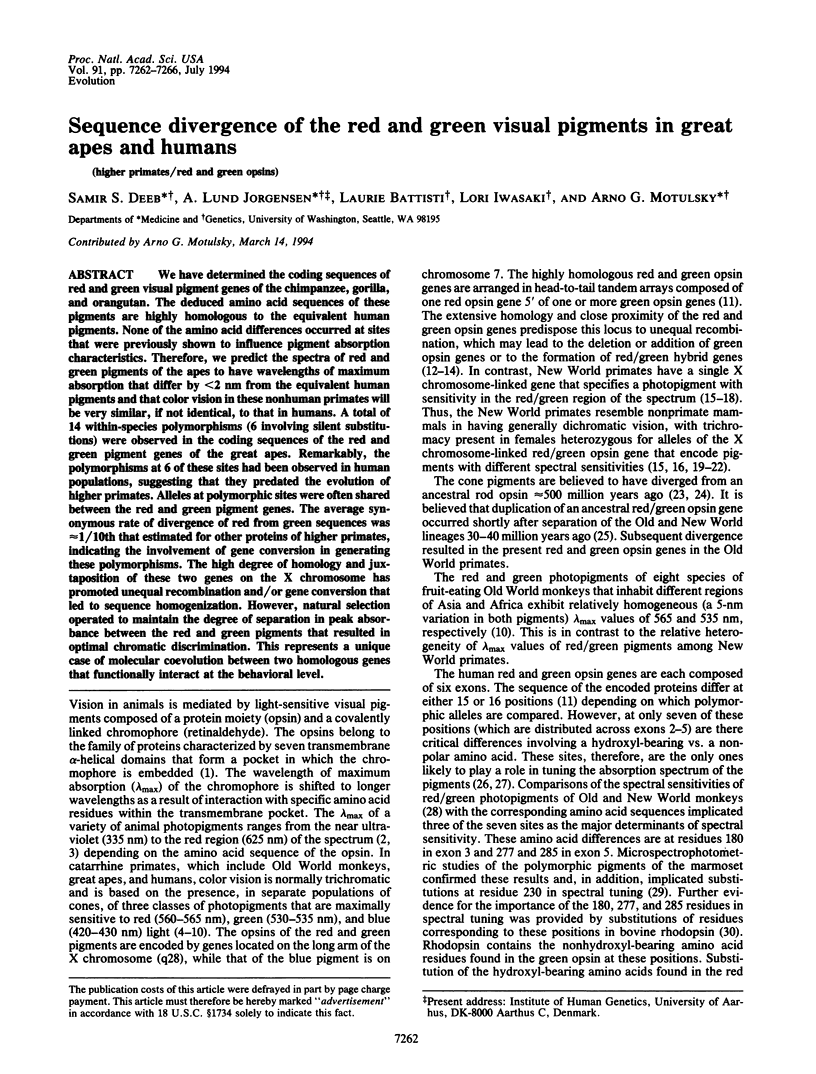
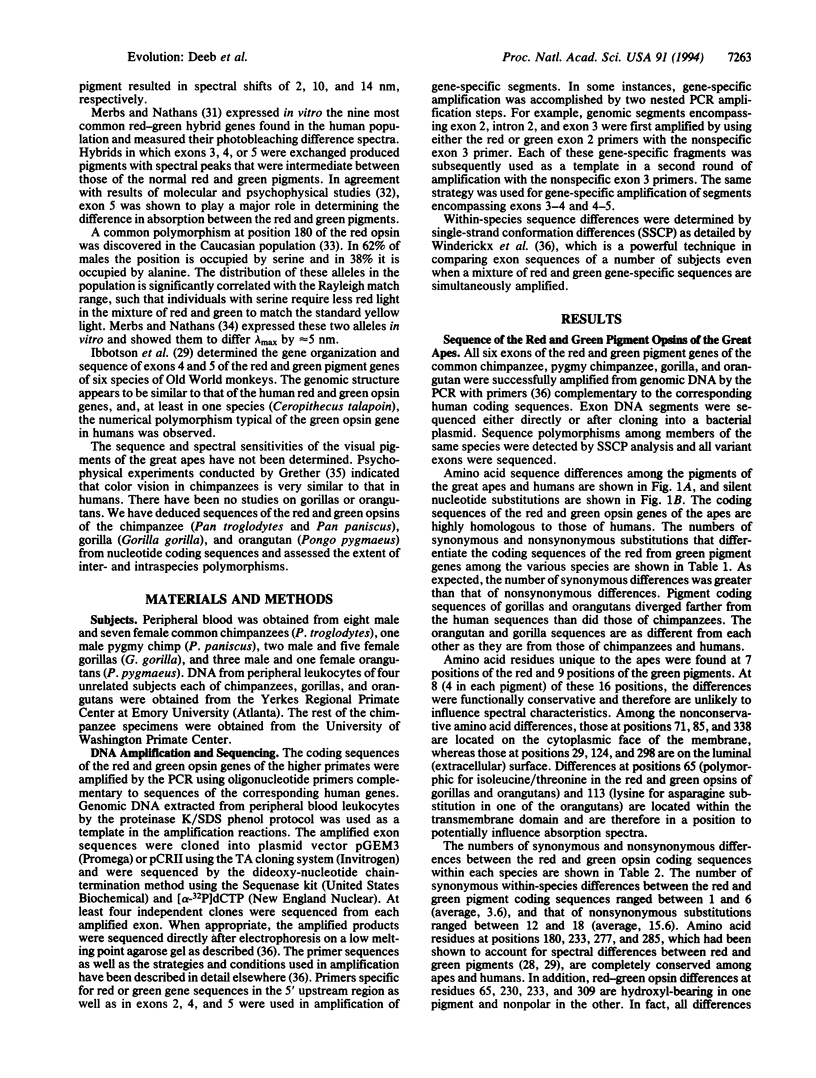
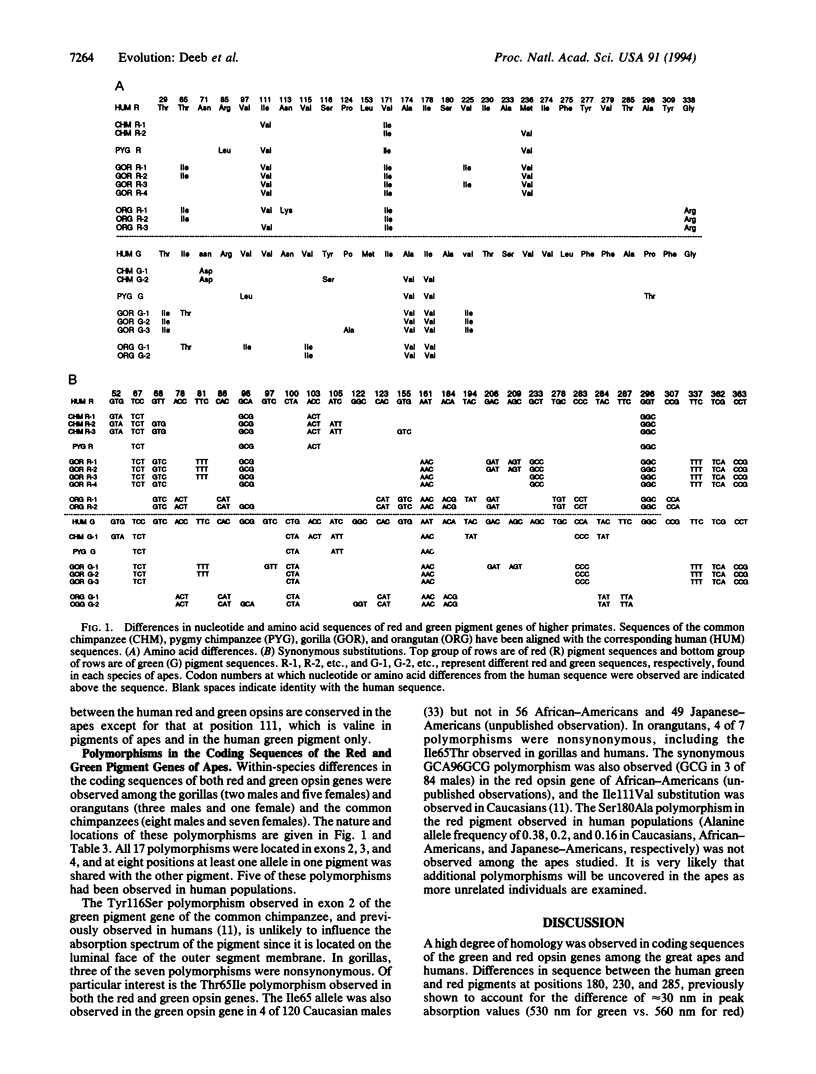
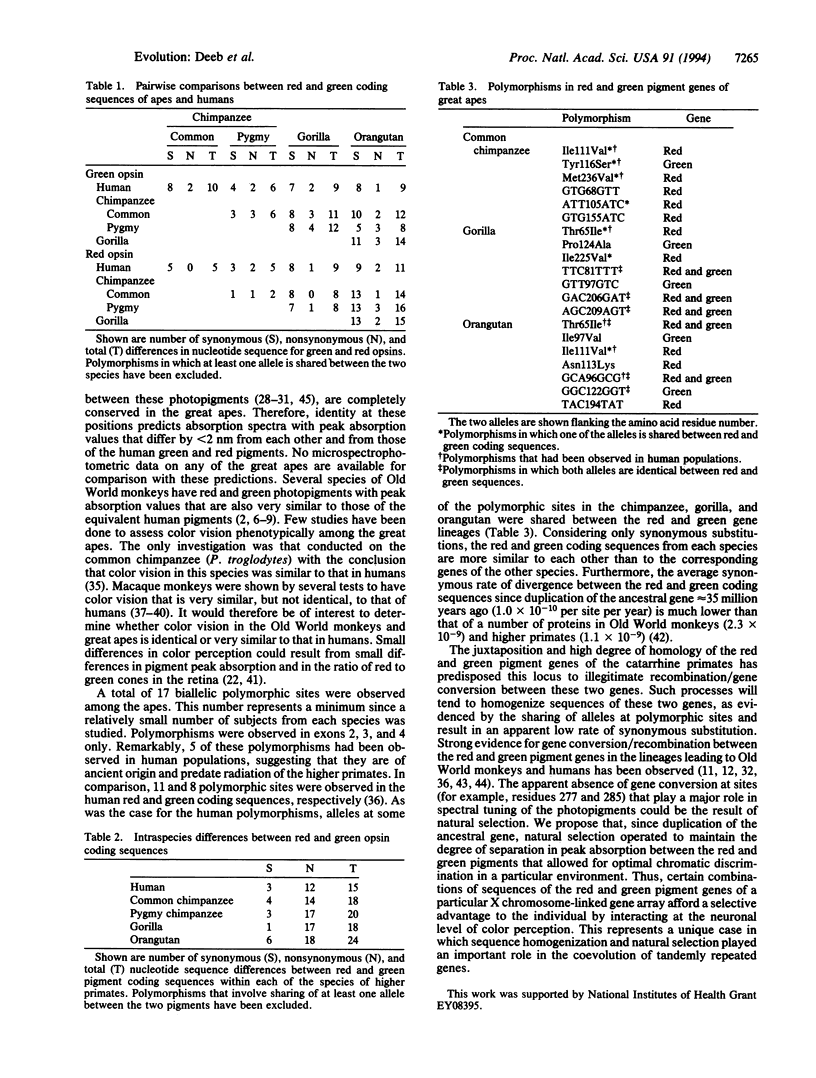
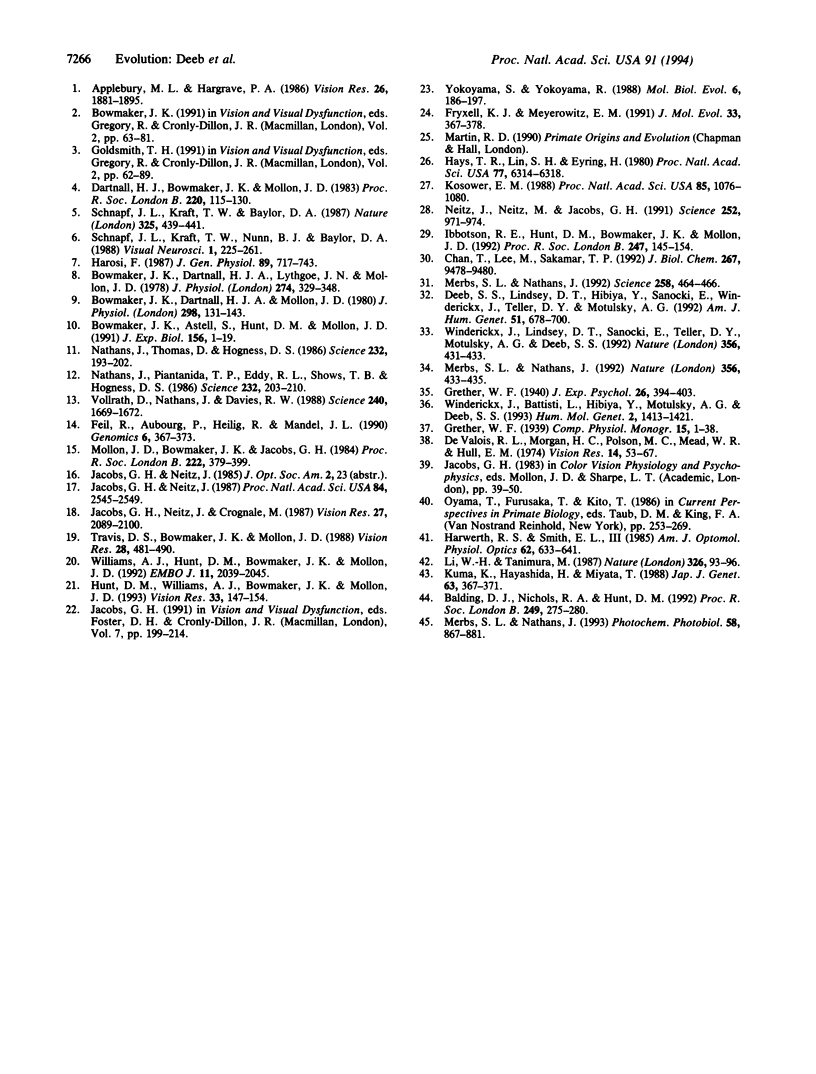
Selected References
These references are in PubMed. This may not be the complete list of references from this article.
- Applebury M. L., Hargrave P. A. Molecular biology of the visual pigments. Vision Res. 1986;26(12):1881–1895. doi: 10.1016/0042-6989(86)90115-x. [DOI] [PubMed] [Google Scholar]
- Balding D. J., Nichols R. A., Hunt D. M. Detecting gene conversion: primate visual pigment genes. Proc Biol Sci. 1992 Sep 22;249(1326):275–280. doi: 10.1098/rspb.1992.0114. [DOI] [PubMed] [Google Scholar]
- Bowmaker J. K., Astell S., Hunt D. M., Mollon J. D. Photosensitive and photostable pigments in the retinae of Old World monkeys. J Exp Biol. 1991 Mar;156:1–19. doi: 10.1242/jeb.156.1.1. [DOI] [PubMed] [Google Scholar]
- Bowmaker J. K., Dartnall H. J., Lythgoe J. N., Mollon J. D. The visual pigments of rods and cones in the rhesus monkey, Macaca mulatta. J Physiol. 1978 Jan;274:329–348. doi: 10.1113/jphysiol.1978.sp012151. [DOI] [PMC free article] [PubMed] [Google Scholar]
- Bowmaker J. K., Dartnall H. J., Mollon J. D. Microspectrophotometric demonstration of four classes of photoreceptor in an old world primate, Macaca fascicularis. J Physiol. 1980 Jan;298:131–143. doi: 10.1113/jphysiol.1980.sp013071. [DOI] [PMC free article] [PubMed] [Google Scholar]
- Chan T., Lee M., Sakmar T. P. Introduction of hydroxyl-bearing amino acids causes bathochromic spectral shifts in rhodopsin. Amino acid substitutions responsible for red-green color pigment spectral tuning. J Biol Chem. 1992 May 15;267(14):9478–9480. [PubMed] [Google Scholar]
- Dartnall H. J., Bowmaker J. K., Mollon J. D. Human visual pigments: microspectrophotometric results from the eyes of seven persons. Proc R Soc Lond B Biol Sci. 1983 Nov 22;220(1218):115–130. doi: 10.1098/rspb.1983.0091. [DOI] [PubMed] [Google Scholar]
- De Valois R. L., Morgan H. C., Polson M. C., Mead W. R., Hull E. M. Psychophysical studies of monkey vision. I. Macaque luminosity and color vision tests. Vision Res. 1974 Jan;14(1):53–67. doi: 10.1016/0042-6989(74)90116-3. [DOI] [PubMed] [Google Scholar]
- Deeb S. S., Lindsey D. T., Hibiya Y., Sanocki E., Winderickx J., Teller D. Y., Motulsky A. G. Genotype-phenotype relationships in human red/green color-vision defects: molecular and psychophysical studies. Am J Hum Genet. 1992 Oct;51(4):687–700. [PMC free article] [PubMed] [Google Scholar]
- Feil R., Aubourg P., Heilig R., Mandel J. L. A 195-kb cosmid walk encompassing the human Xq28 color vision pigment genes. Genomics. 1990 Feb;6(2):367–373. doi: 10.1016/0888-7543(90)90578-i. [DOI] [PubMed] [Google Scholar]
- Fryxell K. J., Meyerowitz E. M. The evolution of rhodopsins and neurotransmitter receptors. J Mol Evol. 1991 Oct;33(4):367–378. doi: 10.1007/BF02102867. [DOI] [PubMed] [Google Scholar]
- Harwerth R. S., Smith E. L., 3rd Rhesus monkey as a model for normal vision of humans. Am J Optom Physiol Opt. 1985 Sep;62(9):633–641. doi: 10.1097/00006324-198509000-00009. [DOI] [PubMed] [Google Scholar]
- Hays T. R., Lin S. H., Eyring H. Wavelength regulation in rhodopsin: effects of dipoles and amino acid side chains. Proc Natl Acad Sci U S A. 1980 Nov;77(11):6314–6318. doi: 10.1073/pnas.77.11.6314. [DOI] [PMC free article] [PubMed] [Google Scholar]
- Hunt D. M., Williams A. J., Bowmaker J. K., Mollon J. D. Structure and evolution of the polymorphic photopigment gene of the marmoset. Vision Res. 1993 Jan;33(2):147–154. doi: 10.1016/0042-6989(93)90153-n. [DOI] [PubMed] [Google Scholar]
- Hárosi F. I. Cynomolgus and rhesus monkey visual pigments. Application of Fourier transform smoothing and statistical techniques to the determination of spectral parameters. J Gen Physiol. 1987 May;89(5):717–743. doi: 10.1085/jgp.89.5.717. [DOI] [PMC free article] [PubMed] [Google Scholar]
- Ibbotson R. E., Hunt D. M., Bowmaker J. K., Mollon J. D. Sequence divergence and copy number of the middle- and long-wave photopigment genes in Old World monkeys. Proc Biol Sci. 1992 Feb 22;247(1319):145–154. doi: 10.1098/rspb.1992.0021. [DOI] [PubMed] [Google Scholar]
- Jacobs G. H., Neitz J., Crognale M. Color vision polymorphism and its photopigment basis in a callitrichid monkey (Saguinus fuscicollis). Vision Res. 1987;27(12):2089–2100. doi: 10.1016/0042-6989(87)90123-4. [DOI] [PubMed] [Google Scholar]
- Jacobs G. H., Neitz J. Inheritance of color vision in a New World monkey (Saimiri sciureus). Proc Natl Acad Sci U S A. 1987 Apr;84(8):2545–2549. doi: 10.1073/pnas.84.8.2545. [DOI] [PMC free article] [PubMed] [Google Scholar]
- Kosower E. M. Assignment of groups responsible for the "opsin shift" and light absorptions of rhodopsin and red, green, and blue iodopsins (cone pigments). Proc Natl Acad Sci U S A. 1988 Feb;85(4):1076–1080. doi: 10.1073/pnas.85.4.1076. [DOI] [PMC free article] [PubMed] [Google Scholar]
- Kuma K., Hayashida H., Miyata T. Recent gene conversion between genes encoding human red and green visual pigments. Jpn J Genet. 1988 Aug;63(4):367–371. doi: 10.1266/jjg.63.367. [DOI] [PubMed] [Google Scholar]
- Li W. H., Tanimura M. The molecular clock runs more slowly in man than in apes and monkeys. Nature. 1987 Mar 5;326(6108):93–96. doi: 10.1038/326093a0. [DOI] [PubMed] [Google Scholar]
- Merbs S. L., Nathans J. Absorption spectra of human cone pigments. Nature. 1992 Apr 2;356(6368):433–435. doi: 10.1038/356433a0. [DOI] [PubMed] [Google Scholar]
- Merbs S. L., Nathans J. Absorption spectra of the hybrid pigments responsible for anomalous color vision. Science. 1992 Oct 16;258(5081):464–466. doi: 10.1126/science.1411542. [DOI] [PubMed] [Google Scholar]
- Mollon J. D., Bowmaker J. K., Jacobs G. H. Variations of colour vision in a New World primate can be explained by polymorphism of retinal photopigments. Proc R Soc Lond B Biol Sci. 1984 Sep 22;222(1228):373–399. doi: 10.1098/rspb.1984.0071. [DOI] [PubMed] [Google Scholar]
- Nathans J., Piantanida T. P., Eddy R. L., Shows T. B., Hogness D. S. Molecular genetics of inherited variation in human color vision. Science. 1986 Apr 11;232(4747):203–210. doi: 10.1126/science.3485310. [DOI] [PubMed] [Google Scholar]
- Nathans J., Thomas D., Hogness D. S. Molecular genetics of human color vision: the genes encoding blue, green, and red pigments. Science. 1986 Apr 11;232(4747):193–202. doi: 10.1126/science.2937147. [DOI] [PubMed] [Google Scholar]
- Neitz M., Neitz J., Jacobs G. H. Spectral tuning of pigments underlying red-green color vision. Science. 1991 May 17;252(5008):971–974. doi: 10.1126/science.1903559. [DOI] [PubMed] [Google Scholar]
- Schnapf J. L., Kraft T. W., Baylor D. A. Spectral sensitivity of human cone photoreceptors. 1987 Jan 29-Feb 4Nature. 325(6103):439–441. doi: 10.1038/325439a0. [DOI] [PubMed] [Google Scholar]
- Schnapf J. L., Kraft T. W., Nunn B. J., Baylor D. A. Spectral sensitivity of primate photoreceptors. Vis Neurosci. 1988;1(3):255–261. doi: 10.1017/s0952523800001917. [DOI] [PubMed] [Google Scholar]
- Travis D. S., Bowmaker J. K., Mollon J. D. Polymorphism of visual pigments in a callitrichid monkey. Vision Res. 1988;28(4):481–490. doi: 10.1016/0042-6989(88)90170-8. [DOI] [PubMed] [Google Scholar]
- Vollrath D., Nathans J., Davis R. W. Tandem array of human visual pigment genes at Xq28. Science. 1988 Jun 17;240(4859):1669–1672. doi: 10.1126/science.2837827. [DOI] [PubMed] [Google Scholar]
- Williams A. J., Hunt D. M., Bowmaker J. K., Mollon J. D. The polymorphic photopigments of the marmoset: spectral tuning and genetic basis. EMBO J. 1992 Jun;11(6):2039–2045. doi: 10.1002/j.1460-2075.1992.tb05261.x. [DOI] [PMC free article] [PubMed] [Google Scholar]
- Winderickx J., Battisti L., Hibiya Y., Motulsky A. G., Deeb S. S. Haplotype diversity in the human red and green opsin genes: evidence for frequent sequence exchange in exon 3. Hum Mol Genet. 1993 Sep;2(9):1413–1421. doi: 10.1093/hmg/2.9.1413. [DOI] [PubMed] [Google Scholar]
- Winderickx J., Lindsey D. T., Sanocki E., Teller D. Y., Motulsky A. G., Deeb S. S. Polymorphism in red photopigment underlies variation in colour matching. Nature. 1992 Apr 2;356(6368):431–433. doi: 10.1038/356431a0. [DOI] [PubMed] [Google Scholar]
- Yokoyama S., Yokoyama R. Molecular evolution of human visual pigment genes. Mol Biol Evol. 1989 Mar;6(2):186–197. doi: 10.1093/oxfordjournals.molbev.a040537. [DOI] [PubMed] [Google Scholar]


